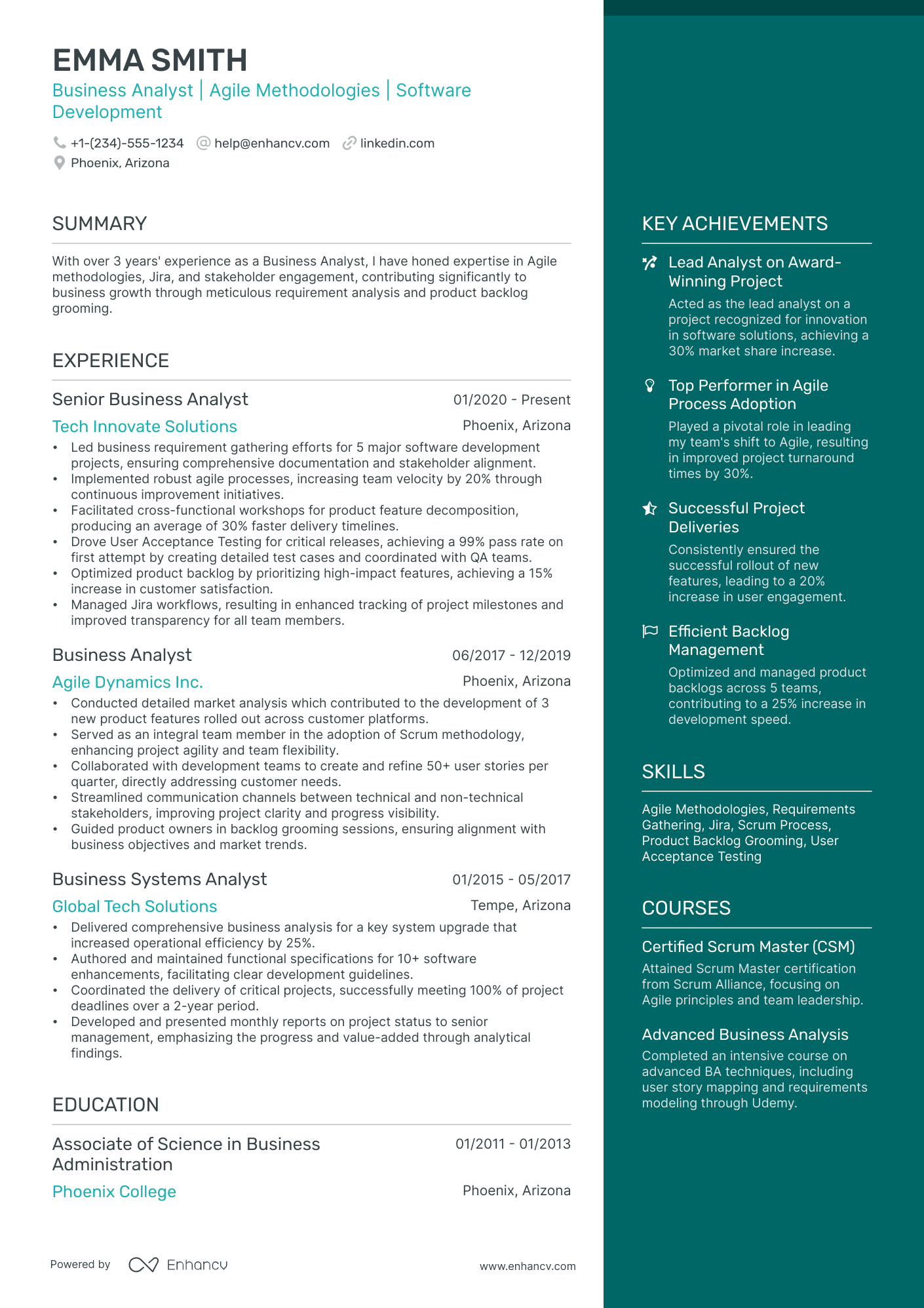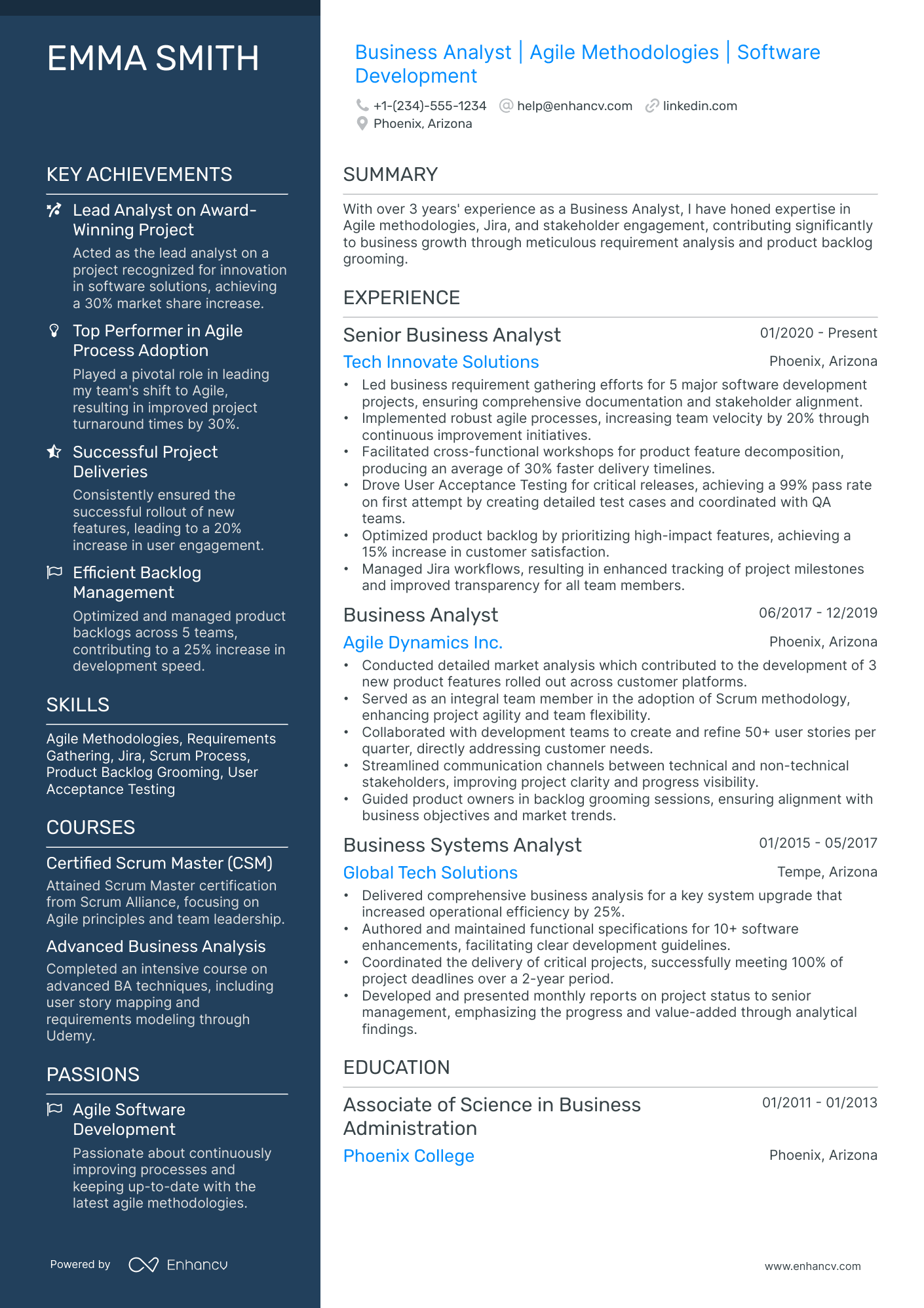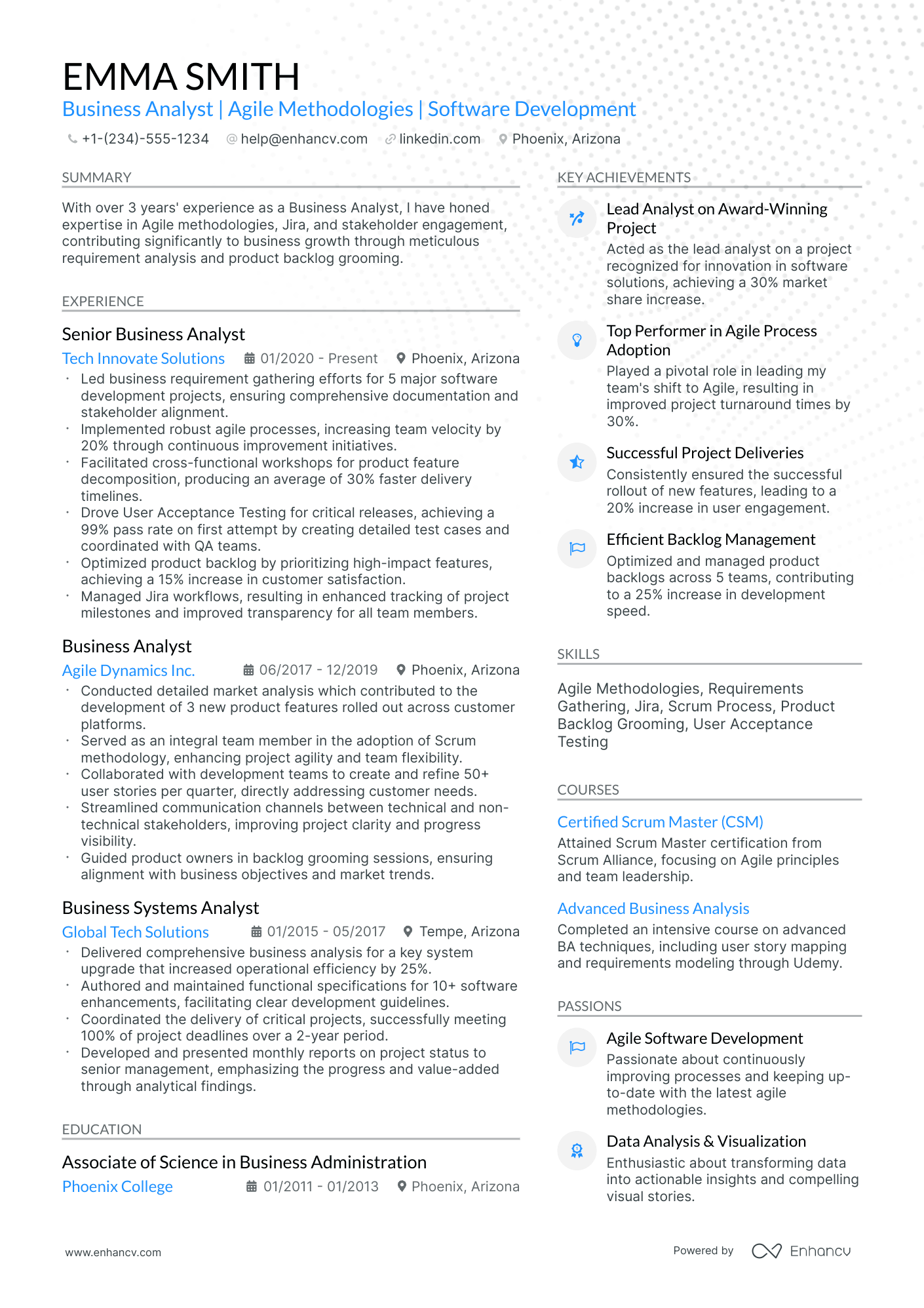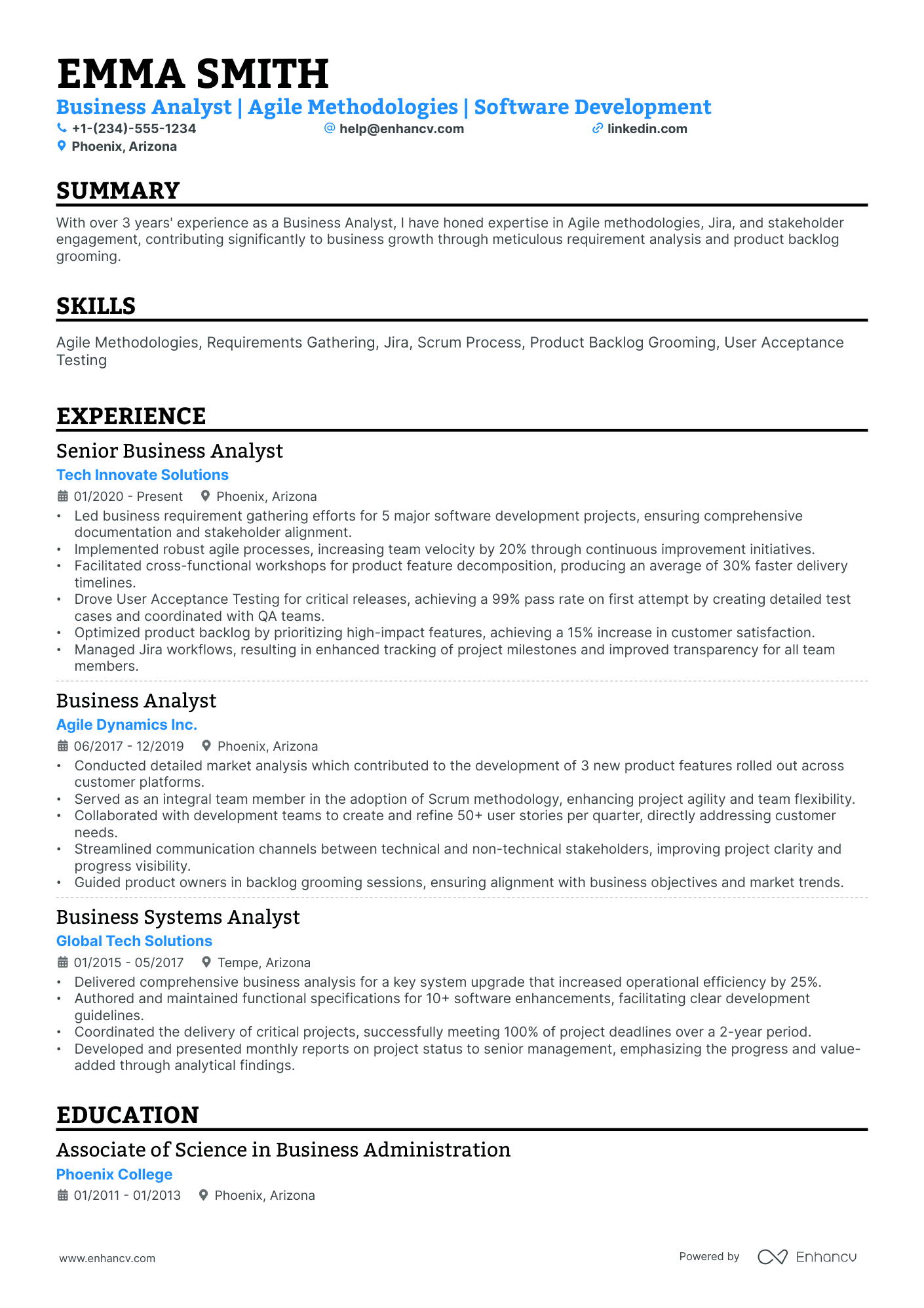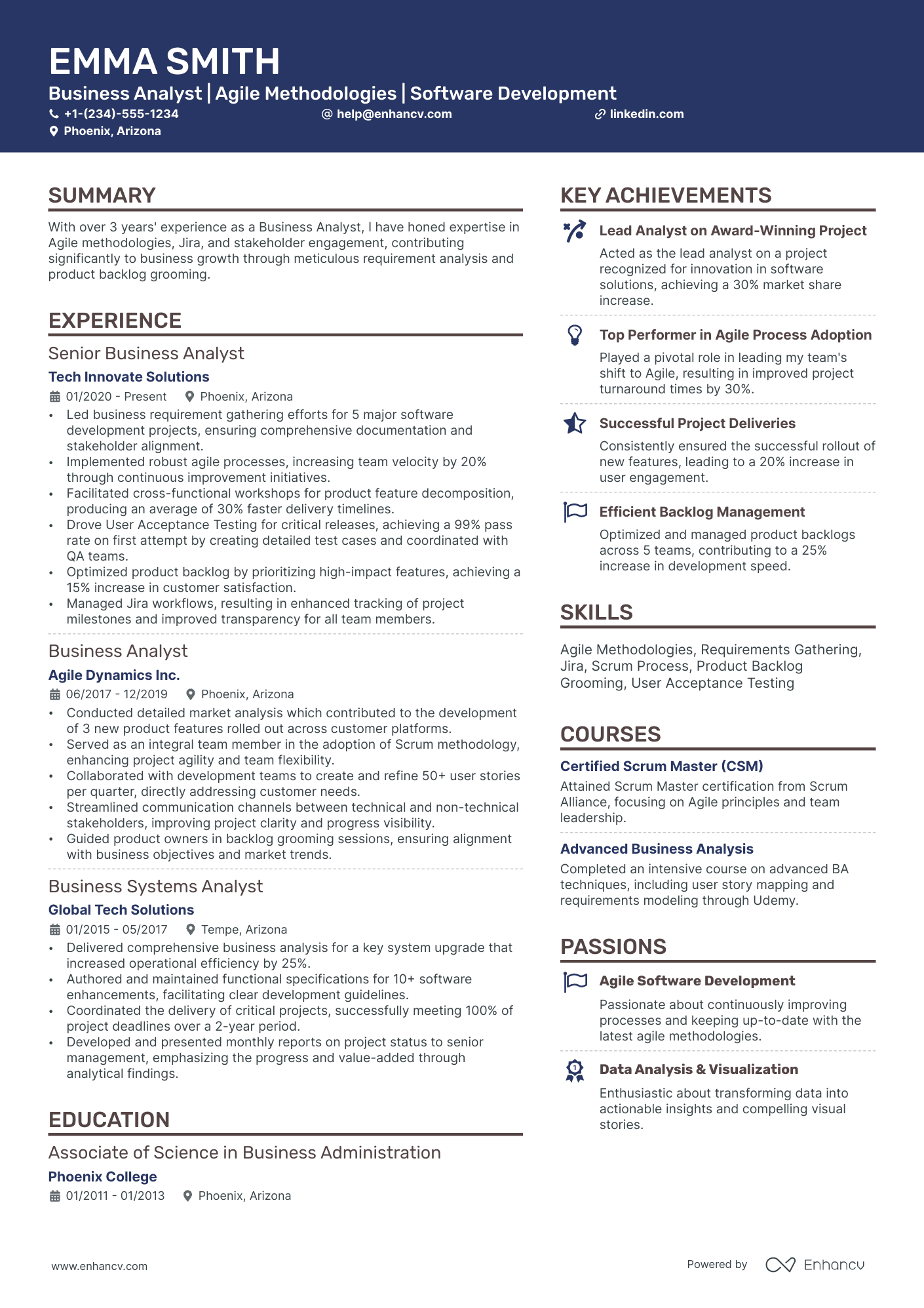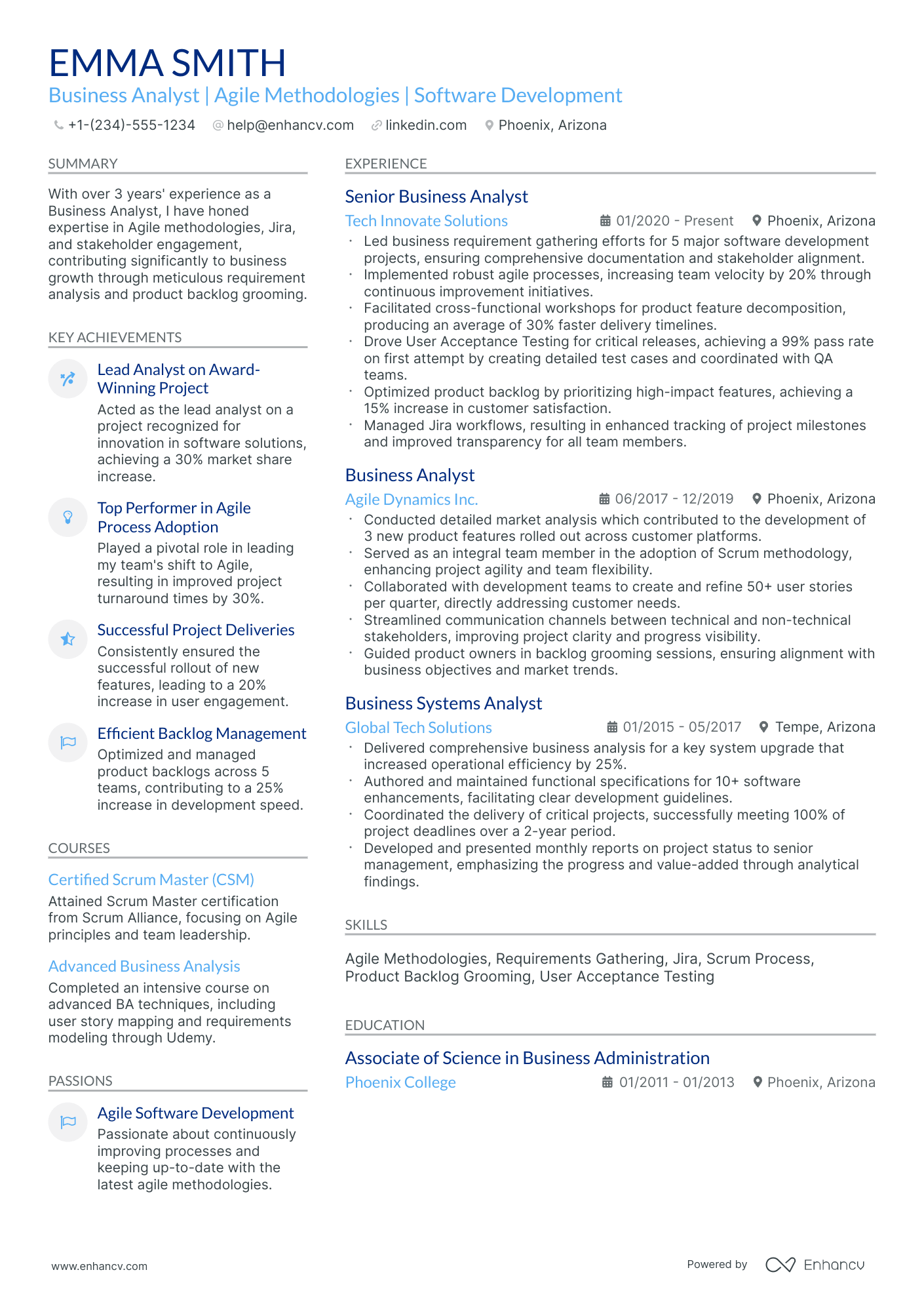Crafting a resume as an agile business analyst can be challenging when trying to concisely convey the breadth of your experience in agile methodologies and stakeholder management. Our guide is tailor-made to help you pinpoint and effectively showcase your most impactful contributions, ensuring you stand out in a competitive job market.
- Which sections do you need to include in your resume to meet recruiters' requirements;
- How to write your agile business analyst resume experience section - even if you have don't have little to no work experience;
- Real-life professional examples to guide you how to write the most important agile business analyst resume sections;
- Adding even more sections so your agile business analyst resume stands out with professionalism and your personality.
We've also selected some of the best (and most relevant) resume guides for the agile business analyst role you're applying for:
- Investment Manager Resume Example
- Healthcare Business Analyst Resume Example
- Senior Business Analyst Resume Example
- Resource Manager Resume Example
- Planning Manager Resume Example
- Proposal Manager Resume Example
- Compliance Manager Resume Example
- Logistics Account Manager Resume Example
- SAP Business Analyst Resume Example
- Business Relationship Manager Resume Example
The ultimate formula for your Agile business analyst resume format
Our best advice on how to style your agile business analyst resume is this - first, take the time to study the job advert requirements.
The resume format you select should ultimately help you better align how your experience matches the specific role.
There are four crucial elements you need to thus take into consideration:
- How you present your experience. If you happen to have plenty of relevant expertise, select the reverse-chronological resume format to organize your experience by dates, starting with the latest.
- Don't go over the top with writing your resume. Instead, stick with a maximum of two-page format to feature what matters most about your profile.
- Headers aren't just for "decoration". The header of your resume helps recruiters allocate your contact details, portfolio, and so much more.
- The PDF format rules. It's the most common practice to submit your agile business analyst resume as a PDF so that your resume doesn't lose its layout. However, make sure the read the job well - in some instances, they might require a doc file.
Think about the market’s preferences – a Canadian resume, for instance, could have a different layout.
Upload & Check Your Resume
Drop your resume here or choose a file. PDF & DOCX only. Max 2MB file size.
PRO TIP
Highlight any significant extracurricular activities that demonstrate valuable skills or leadership.
Recruiters' preferred agile business analyst resume sections:
- A header with relevant contact information and headline, listing your current job title
- A resume summary or objective pinpointing what is most impressive about your expertise (that aligns with the role)
- An experience section highlighting the specifics of your responsibilities and achievements
- A skills sidebar to intertwine job advert keywords with your unique talents
- An education and certifications sections to serve as further accreditation to your professional experience
What recruiters want to see on your resume:
- Demonstrable experience in Agile methodologies (e.g., Scrum, Kanban) and Agile tools (e.g., JIRA, Confluence).
- Understanding of business process reengineering and requirements gathering/analysis techniques specific to Agile projects.
- Ability to create detailed user stories, acceptance criteria, and Agile artifacts that facilitate clear communication between business stakeholders and technical teams.
- Experience with backlog management, iteration planning, and elaboration of the user stories.
- Proven track record of successful collaboration in a multi-disciplinary team environment, exhibiting strong interpersonal and stakeholder management skills.
Quick formula for writing your Agile business analyst resume experience section
Have you ever wondered why recruiters care about your agile business analyst expertise?
For starters, your past roles show that you've obtained the relevant on-the job training and expertise that'd be useful for the role.
What is more, the resume work experience section isn't just your work history , but:
- shows what you're capable of achieving based on your past success;
- proves your skills with (oftentimes, tangible) achievements;
- highlights the unique value of what it's like to work with you.
To ensure your resume work experience section is as effective as possible, follow this formula:
- start each bullet with a powerful, action verb , followed up by your responsibilities, and your workplace success.
The more details you can include - that are relevant to the job and linked with your skill set - the more likely you are to catch recruiters' attention.
Additionally, you can also scan the job advert for key requirements or buzzwords , which you can quantify across your experience section.
Not sure what we mean by this? Take inspiration from the agile business analyst resume experience sections below:
- Spearheaded the transition to an Agile framework for a 50-person development team, enhancing productivity by 35% within the first year.
- Devised and implemented a dynamic requirements management process that reduced project lead times by an average of 20% while increasing stakeholder satisfaction.
- Collaborated on the launch of a multimillion-dollar project, directly contributing to a 15% increase in the company's annual revenue through process optimization.
- Led the agile transformation of three cross-functional teams, resulting in a 25% improvement in deployment frequency.
- Facilitated the continuous improvement efforts for Scrum teams which boosted overall quality metrics by 30%.
- Performed in-depth market analyses to inform product backlogs, significantly contributing to the development of two groundbreaking software products.
- Designed and instituted a bespoke Agile metrics dashboard that provided real-time insights, improving project visibility for stakeholders.
- Conducted extensive user story mapping sessions, aiding in the delivery of a customized CRM system 3 months ahead of the deadline.
- Managed a diverse stakeholder group throughout the lifecycle of a complex enterprise solution, ensuring requirements were met and exceeded.
- Optimized backlog prioritization processes, which resulted in a 40% increase in customer satisfaction scores.
- Drove the integration of user feedback into the development process, leading to a 20% improvement in product usability.
- Conducted competitive analysis for key software features, directly influencing the strategic roadmap for product development.
- Streamlined cross-departmental communication through the adoption of tailored Agile practices, achieving a 15% reduction in time-to-market.
- Developed and facilitated Agile training workshops for over 100 employees, notably enhancing collaboration across the company.
- Engaged closely with product teams to refine user stories and acceptance criteria, ensuring a customer-centric approach to development.
- Assisted with backlog grooming and sprint planning activities, materially increasing team velocity by 10% within six months.
- Collaborated on a market research project that informed a pivot in product strategy, capturing a previously untapped customer segment.
- Helped implement an automated reporting system for Agile metrics, reducing manual data entry errors by 90%.
Quantifying impact on your resume
- Include the number of successful projects you have led or played a key role in to demonstrate experience and effectiveness.
- List the sizes of the teams you have worked with to show your capability in collaborating with and influencing various team dynamics.
- Mention the percentage of processes you have optimized, showcasing your efficiency in improving business procedures.
- Quantify the monetary value of the projects you have worked on to illustrate your impact on the organization's bottom line.
- State the amount of time or resources saved through your analytical solutions, emphasizing your problem-solving skills.
- Document the number of stakeholders you have engaged with to highlight your communication skills and stakeholder management.
- Specify the percentage increase in customer satisfaction or user adoption rates due to your analysis to prove your user-centric focus.
- Record the number of business requirements you've successfully defined and managed to show your expertise in requirements engineering.
Action verbs for your agile business analyst resume
Experience section for candidates with zero-to-none experience
While you may have less professional experience in the field, that doesn't mean you should leave this section of your resume empty or blank.
Consider these four strategies on how to substitute the lack of experience with:
- Volunteer roles - as part of the community, you've probably gained valuable people (and sometimes even technological capabilities) that could answer the job requirements
- Research projects - while in your university days, you may have been part of some cutting-edge project to benefit the field. Curate this within your experience section as a substitute for real-world experience
- Internships - while you may consider that that summer internship in New York was solely mandatory to your degree, make sure to include it as part of your experience, if it's relevant to the role
- Irrelevant previous jobs - instead of detailing the technologies you've learned, think about the transferable skills you've gained.
Recommended reads:
PRO TIP
If you failed to obtain one of the certificates, as listed in the requirements, but decide to include it on your resume, make sure to include a note somewhere that you have the "relevant training, but are planning to re-take the exams". Support this statement with the actual date you're planning to be re-examined. Always be honest on your resume.
Bringing your Agile business analyst hard skills and soft skills to the forefront of recruiters' attention
Hard skills are used to define the technological (and software) capacities you have in the industry. Technical skills are easily defined via your certification and expertise.
Soft skills have more to do with your at-work personality and how you prosper within new environments. People skills can be obtained thanks to your whole life experience and are thus a bit more difficult to define.
Why do recruiters care about both types of skills?
Hard skills have more to do with job alignment and the time your new potential employers would have to invest in training you.
Soft skills hint at how well you'd adapt to your new environment, company culture, and task organization.
Fine-tune your resume to reflect on your skills capacities and talents:
- Avoid listing basic requirements (e.g. "Excel"), instead substitute with the specifics of the technology (e.g. "Excel Macros").
- Feature your workplace values and ethics as soft skills to hint at what matters most to you in a new environment.
- Build a separate skills section for your language capabilities, only if it makes sense to the role you're applying for.
- The best way to balance agile business analyst hard and soft skills is by building a strengths or achievements section, where you define your outcomes via both types of skills.
There are plenty of skills that could make the cut on your resume.
That's why we've compiled for you some of the most wanted skills by recruiters, so make sure to include the technologies and soft skills that make the most sense to you (and the company you're applying for):
Top skills for your agile business analyst resume:
JIRA
Confluence
Agile methodologies
User story mapping
Business process modeling
SQL
Data analysis tools (e.g., Excel, Tableau)
Wireframing tools (e.g., Balsamiq, Axure)
API understanding
Requirement gathering techniques
Communication
Collaboration
Critical thinking
Problem-solving
Adaptability
Attention to detail
Time management
Stakeholder management
Negotiation
Facilitation
PRO TIP
Always remember that your agile business analyst certifications can be quantified across different resume sections, like your experience, summary, or objective. For example, you could include concise details within the expertise bullets of how the specific certificate has improved your on-the-job performance.
Certifications and education: in-demand sections for your Agile business analyst resume
Your academic background in the form of certifications on your resume and your higher degree education is important to your application.
The certifications and education sections pinpoint a variety of hard and soft skills you possess, as well as your dedication to the industry.
Add relevant certificates to your agile business analyst resume by:
- Add special achievements or recognitions you've received during your education or certification, only if they're really noteworthy and/or applicable to the role
- Be concise - don't list every and any certificate you've obtained through your career, but instead, select the ones that would be most impressive to the role
- Include the name of the certificate or degree, institution, graduation dates, and certificate license numbers (if possible)
- Organize your education in reverse chronological format, starting with the latest degree you have that's most applicable for the role
Think of the education and certification sections as the further credibility your agile business analyst resume needs to pinpoint your success.
Now, if you're stuck on these resume sections, we've curated a list of the most popular technical certificates across the industry.
Have a look, below:
The top 5 certifications for your agile business analyst resume:
- Certified ScrumMaster (CSM) - Scrum Alliance
- Professional Scrum Master (PSM) - Scrum.org
- Certified Business Analysis Professional (CBAP) - International Institute of Business Analysis (IIBA)
- Agile Certified Practitioner (PMI-ACP) - Project Management Institute
- Certification of Competency in Business Analysis (CCBA) - International Institute of Business Analysis (IIBA)
PRO TIP
The more trusted the organization you've attained your certificate (or degree) from, the more credible your skill set would be.
Recommended reads:
Agile business analyst resume summaries or objectives: real-world samples for best industry practices
Grasp recruiters' attention from the get-go of your application with a professional agile business analyst resume summary or objective.
It's wise to select the:
- Resume objective , if you don't happen to have much experience alignment and would like to more prominently feature your dreams and personality.
- Resume summary , if you'd like to have a more standard approach to your application and feature up to five career highlights to help you stand out.
Writing your resume summary or objective should be tailored to each role you apply for.
Think about what would impress the recruiters and go from there.
But, if you need further help with this introductory section, check out some real-world samples in the next part of this guide:
Resume summaries for a agile business analyst job
- Seasoned agile business analyst with over 8 years of experience in driving successful projects in the FinTech sector. Expert in requirements gathering, process modeling, and user story creation. Spearheaded the digital transformation of a major banking institution, resulting in a 40% increase in process efficiency.
- Dynamic former Software Developer making a strategic pivot to Business Analysis, with a solid foundation in agile methodologies and a deep understanding of the SDLC. Leveraging 5 years of coding experience to bridge the gap between technical teams and stakeholders, aiming to optimize product development and customer satisfaction.
- Recently transitioned from Systems Engineering to Agile Business Analysis, bringing a unique perspective on infrastructure and systems optimization. Equipped with 6 years of experience in complex systems management and a passion for continuous improvement to drive effective agile processes in product development environments.
- Highly motivated professional with a Master's degree in Information Systems eager to apply a fresh perspective to Agile Business Analysis. Combines strong analytical skills with a passion for technology and a commitment to achieving business goals, aspiring to leverage untapped potentials in software development cycles.
- Enthusiastic career starter with a Bachelor's degree in Business Management and a certification in Agile Methodologies. Intent on applying a rigorous academic background and a keen interest in technology solutions to develop into a proficient agile business analyst through hands-on experience and mentorship.
Other relevant sections for your Agile business analyst resume
Apart from the standard agile business analyst resume sections listed in this guide, you have the opportunity to get creative with building your profile. Select additional resume sections that you deem align with the role, department, or company culture. Good choices for your agile business analyst resume include:
- Language skills - always ensure that you have qualified each language you speak according to relevant frameworks;
- Hobbies - you could share more about your favorite books, how you spend your time, etc. ;
- Volunteering - to highlight the causes you care about;
- Awards - for your most prominent agile business analyst professional accolades and achievements.
Make sure that these sections don't take too much away from your experience, but instead build up your agile business analyst professional profile.
Key takeaways
- The logic of your resume presentation should follow your career highlights and alignment with the role;
- Curate information within different sections (e.g. summary, experience, etc.) that helps highlight your strengths;
- Exclude from your resume irrelevant experience items - that way you'd ensure it stays no longer than two pages and is easy to read;
- Dedicate space within the summary, experience, and/or achievements to highlight precisely why you're the best candidate for the role via your previous success;
- Both your technical and people capabilities should also play a crucial role in building up your agile business analyst application. Prove your skill set in various resume sections.

